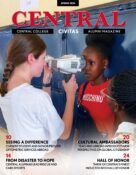
The average American uses 80-100 gallons of water per day. For a week in March, the students in Ellen Du Pre’s Epidemiology course used only 3 gallons a day.
Epidemiology is the study of the patterns and causes of diseases and other health issues. Du Pre, professor of biology, says that the worldwide lack of access to clean water and sanitation contributes to several health issues. So she decided to open her students’ eyes. “Reading about water issues has much less of an impact on a person that walking a mile in someone’s shoes,” she says.
For four days in March, students carried around a 3-gallon of water everywhere they went. That was the only water they were allowed to use for the day—for drinking, washing their hands, brushing their teeth and bathing. In some parts of the world, Du Pre explains, people have only 5 gallons of water to use every day. The professor settled on 3 gallons since the students wouldn’t be using their water to flush toilets, do laundry or wash dishes in Central Market.
Rachel Frana, a sophomore environmental studies major and global health minor, was initially excited for the project, but after an intense spring break on a Flying Pans tour, she dreaded adding the water conservation to her busy schedule. Steeling herself for a stressful week, she found the project easy and satisfying. By the end, she had 5 gallons left to use, even after bathing twice by pouring water over herself in the shower.
Frana made it her goal that week to be as presentable as always, because her friends assumed her hygiene would take a hit. Instead, they found she was clean and odor-free. “In America, especially with this generation, we have a stigma that if you don’t bathe every day or take a 30-minute shower to boil off your skin, then you won’t be clean,” she says. “And it’s really not true.”
Kyle Freischlag, a junior history and biology major with plans for medical school, also found that other students were prone to make sarcastic comments. Carrying around the 3-gallon jug with water statistics and the phrase “Ask me why I’m carrying this” posted on the side, Freischlag was subject to lots of inquiries from those on campus. In addition to sarcasm, many people showed pity for his ordeal. But Freischlag says that wasn’t the message they were trying to get across. They weren’t looking for sympathy—but understanding.
Frana explains the goals of the project. “On one side, it was to help bring awareness of how difficult it is for people living in situations with limited water,” she says. “On the other side, we wanted to show that Americans are being overly wasteful and taking advantage of the water we have.”
As the week progressed, the water-toting students did receive more positive responses from classmates and professors. But the biggest change in perspective was their own. “They began to understand that to learn we often have to leave our comfort zones,” says Du Pre. “Being uncomfortable makes us reflect on behavior, culture and decision-making.”
At the end of the week, some students in the class made decisions to change their lifestyles. Freischlag modified his shaving habits, and Frana began turning off the water in the shower, using it only to get wet and then rinse. She found she could rinse completely with only two bottles of water.
Freischlag finds himself thinking about water all the time now. “Water becomes self-evident in your life,” he says, “It is essential for life, but we use it recklessly in our society. You don’t realize how recklessly until you don’t have as much anymore.”
The Epidemiology students also planned an Oxfam Hunger Banquet to demonstrate global food disparity. Read about the banquet online at news.central.edu.












To encourage serious, intellectual discourse on Civitas, please include your first and last name when commenting. Anonymous comments will be removed.
Comments are closed.